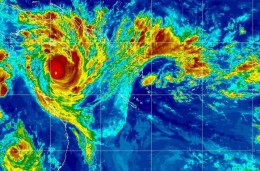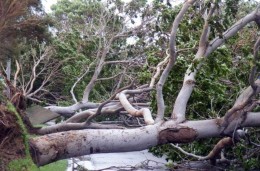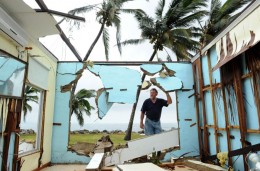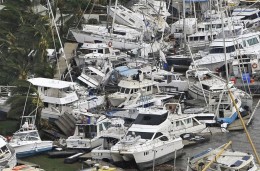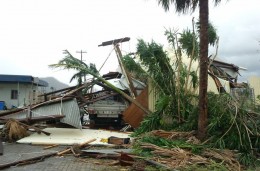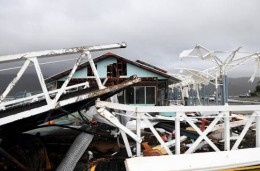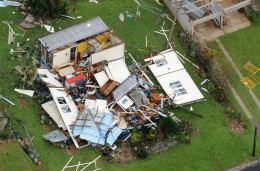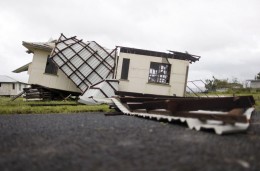News
Cyclone Season is Here: Be Prepared!
Coastlines are exposed to the potentially deadly annual threat of tropical cyclones.
Many of Australia's most beautiful and popular coastlines lie in our northern tropical regions, from Broome in the northwest, across the Top End and around to the Whitsundays in the northeast. But while being beautiful places to live and visit, these coastlines are exposed to the potentially deadly annual threat of tropical cyclones. From November through to April, the task falls on those who reside in these areas to be prepared to ensure the safety of their loved ones and property if a cyclone strikes.
Cyclone Categories
Cyclones are rated from Category 1 (winds less than 125km/hr), where the most common impact is damage to crops, to Category 5 (winds in excess of 278 km hr), where they can be responsible for widespread destruction. The highest risks for residents are from building collapses, flooding, and everyday objects suddenly becoming windborne and dangerous. While as many as five destructive cyclones can impact each area per year, statistics show there has always been at least one per year that makes landfall, sometimes with serious loss of life and property. Scientist have also noted an increase in the number of Category 4 and 5 cyclones in Australia since the 1970s, although the total number of cyclones recorded globally has not increased. For residents, this means being prepared for the likelihood of more intense cyclones by having well built, well maintained homes and effective emergency plans.
Are you "up to code"?
Improved weather forecasting means the arrival of cyclones can be identified up to 12 hours in advance, allowing time for residents to decide if they will stay in their homes or seek shelter elsewhere. The primary option for many who live in cyclone-prone regions will be to shelter in their own home. However, this is only a choice if the home is able to withstand the potential cyclone impacts through meeting the Building Code of Australia’s guidance for the region. Those who live in the impacted zones must have their homes designed and built to withstand mid-range Category 4 cyclones which includes winds between 225-279 km/h.
An important part of achieving a compliant home is in the selection of the right products for window and door framing and screening. Any such products should be tested to meet the Australian Standard to ensure they will endure cyclonic impacts. If a product has passed the tests, it will feature the "cyclonic tested" logo, confirming it is suitable for what are described as Region C and D cyclone prone areas as set out in the Standard. Companies such as Alspec produce a range of window and door framing as well as screening products which meet or exceed the cyclonic testing standards.
Unsure about your home's construction? Your local council or building authority should be able to provide information on your home’s compliance or help you have your home inspected by an approved professional.
Have you done your maintenance checks?
It’s all very well to have a home that was built to code 10 years ago, but has it been well- maintained? Environmental impacts from day-to-day weathering and living near the sea can contribute to the corrosion of important structural elements and fastenings. In regions prone to termite attacks, impacts can easily go unnoticed unless regular inspections are undertaken.
Prior to the cyclone season, conduct your own audit by starting at the perimeter of your property and working your way to the centre, checking:
- Are there any trees on your land (or public land) that need trimming?
- Are there items around the yard that should be put way (tools, equipment, loose materials)?
- Are sheds and garages ready to secure large items such as boats and trailers if needed?
- Is the rainwater tank securely fastened to its footings with no signs of corrosion?
- Are the house foundations secure and termite free?
- Are window screens and fastenings secure and in working order?
- Are the roof gutters clear of leaves and debris?
- Are all roof materials such as tiles or sheeting secure?
If you’re unsure about the state of any items, employ a professional to investigate. A few dollars spent on preventative measures might save many dollars in the event of cyclone.
Where’s the emergency plan?
While weather forecasters try to give advance warning, cyclones can be unpredictable and change course at short notice. Your emergency plan needs to be ready to go, not something you’ll do ‘if it happens’. A good plan includes consideration of the following:
- agreed meeting place if family members become separated
- responsibilities for maintaining the emergency survival kit (includes a first aid kit and provisions for the family for 72 hours)
- location of nearest shelter if a Category 5 cyclone is predicted
- nearest high ground if you may be impacted by flooding or a storm surge
- instructions for turning off utilities (electricity, gas, water)
- a plan for livestock and pets.
A helpful emergency plan template can be downloaded from the Northern Territory Government website.
If a cyclone is forecast, make sure you are signed up for social media alerts from your state’s emergency service websites. You can locate these through the national site: http://www.emergencyalert.gov.au. As mobile and landline services can be impacted by the storms, make sure you have a portable radio handy (with spare batteries) so you can keep informed.
While there is a national emergency alert system which calls the landlines and mobiles of those affected, it relies on your address being up to date. Contact your mobile phone service provider to ensure they have your current address.
Prepared + planned = peace of mind
If you’ve checked your home at the start of the season, and have your emergency plan at the ready, you will be well prepared if a cyclone warning is issued. While the Bureau of Meteorology is forecasting potentially fewer cyclones this season due to the El Niño weather cycle, the reality is it only takes one cyclone to have a devastating impact on you and your community.
Follow the advice from your local emergency services and be prepared to follow your evacuation plan if a Category 5 warning is issued. Being prepared for a cyclone will not only give you peace of mind in the event of an emergency, but will make the reality less traumatic and ensure your family and property are as safe and secure as possible when the time comes.
© Copyright Aluminium Specialties Group Pty Ltd. All Rights Reserved.




























































































